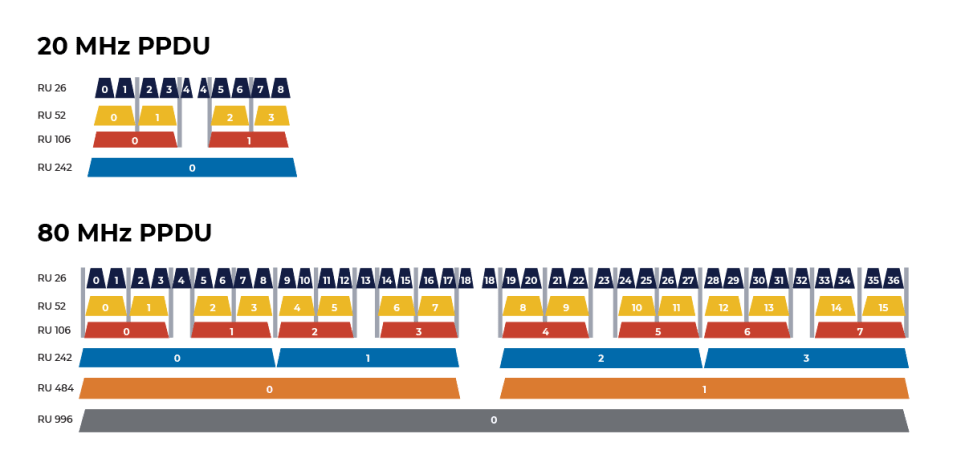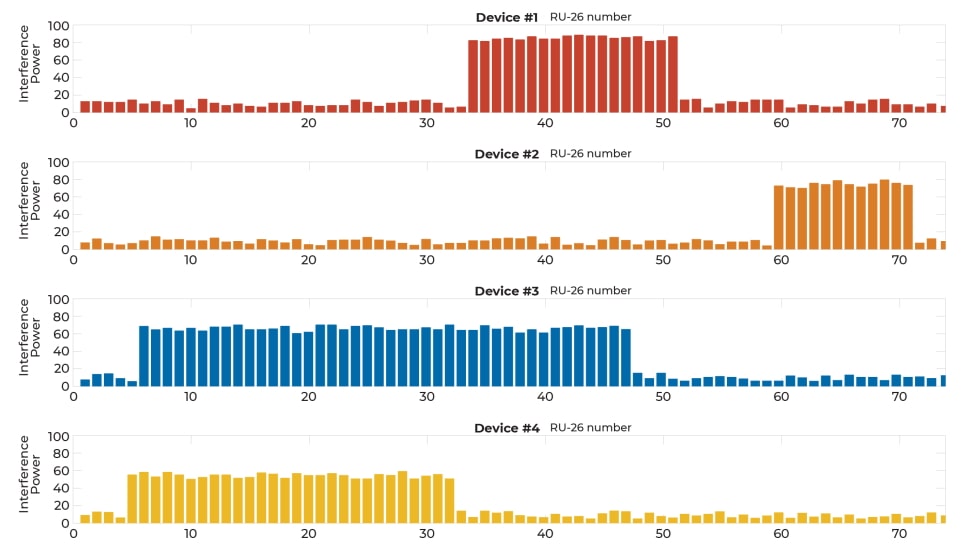Introduction
Wi-Fi 6 is the next-generation wireless technology that offers higher speeds but more importantly, it improves signal reliability, network capacity and efficiency in dense deployments. The two notable features that enable this increased network speed and efficiencies are the support for the higher channel bandwidth of 160MHz (vs. 80MHz of Wi-Fi 5 and 40MHz of Wi-Fi 4) and the MU-OFDMA which enables operating in a subset of the bandwidth called Resource Unit (“RU”) which can be as small as 2MHz.
While the 160MHz channel bandwidth is perceived to be strongly associated with “high throughput” and “fast” applications, the small bandwidth “RU” concept is often tied to “low throughput” and “low key” applications such as in the IoT space.
It is natural to wonder whether there is a benefit in choosing a high-end, new generation, 160MHz capable solution if the intended use case may not demand more than a few 100kbps of throughput at any time.
Well, the answer is a big YES. Wi-Fi 6 is all about improving the efficiency of Wi-Fi networks in dense deployments and is less focused on increasing peak throughput – something which was the case in previous Wi-Fi standard generations. So even though one of the benefits of Wi-Fi 6 could be increased peak throughput and 160MHz is certainly a contributor to it, the combination of 160MHz and MU-OFDMA has a major contribution to the higher efficiency and higher overall throughput of dense networks.
The selection and deployment of 160MHz capable client devices can help realize the true potential of a Wi-Fi 6 network, including the 4x efficiency improvement compared to a Wi-Fi 5 network.
How 160MHz devices improve network efficiency and resiliency of dense networks
A 160MHz device can improve the efficiency of the network in two independent ways:(1) The 160MHz channel bandwidth with higher throughput reduces the airtime taken for each packet transfer and (2) the MU-OFDMA allows transmission of packets from more devices simultaneously. Another benefit of 160MHz devices when combined with the MU-MIMO is the improved network resiliency by reducing the impact of interference. Together, these features make all the applications, high and low throughput, more efficient and resilient.
Reduced airtime for improved network efficiency
Consider the case of dense deployments such as in a home with 20-30 devices or commercial deployment (enterprise, factory, building) with many IoT endpoints and employees. The air medium in such deployments is very congested as every device tries to get an opportunity to transmit or receive data. Operating 160MHz capable devices in this scenario means that they would consume very short airtime to transfer packets. This would be true for all packet sizes, small and large.
The reduced airtime a device requires for a certain packet load, the higher its chance to utilize the air medium. Otherwise, packet hold time will increase exponentially, and in severe cases, quick escalation would happen and the network may effectively stall with no practical network capacity.
We have seen cases that crossing a threshold of 50-70% load may quickly deteriorate a network’s performance if too many of the STAs are just not fast enough to carry over its packets in a short enough available time slot.
By utilizing 160MHz channels (vs. smaller bandwidth), the air medium time is removed from being the limiting factor for the network performance.
As an example, consider a device that needs to send one packet per second. Certainly not a demanding application. With fast 160MHz channel capable of operating in 100s of Mbps or even in excess of 1Gbps – the STA will be able to finish the transmission in a matter of a few milliseconds – increasing its likelihood of consistently finding an open air slot to transmit it – even in a loaded, saturated network that supports 50 or more clients.
Increased simultaneous transmission of more client devices
MU-OFDMA in Wi-Fi 6 organizes the channel bandwidth into a number of RUs of varying bandwidths to enable the transfer of packets of different sizes from multiple clients simultaneously. As illustrated below, the smallest RU uses 26 tones and occupies about 2MHz bandwidth. At any given time, a single channel can be arranged into multiple RUs of different sizes simultaneously. This allows the allocation of different bandwidth to different client devices based on their needs. But a 20MHz channel or even an 80MHz channel is not wide enough to serve a large number of devices in a dense network with many overlapping Access Points. A 160MHz channel with 74 RUs of 26 tones each has a lot more flexibility in terms of how the channel is organized with different sizes of the RUs as shown below.

Just as 80MHz PPDU is 4 x 20MHz PPDU, so 160MHz is 2 x 80MHz PPDU with 74 RUs of 26 tones
| RU type | 20MHz BW | 40MHz BW | 80MHz BW | 80+80/160MHz BW |
|---|---|---|---|---|
| 26-tone RU | 9 | 18 | 37 | 74 |
| 52-tone RU | 4 | 8 | 16 | 32 |
| 106-tone RU | 2 | 4 | 8 | 16 |
| 242-tone RU | 1 | 2 | 4 | 8 |
| 484-tone RU | N/A | 1 | 2 | 4 |
| 996-tone RU | N/A | N/A | 1 | 2 |
| 2X996-tone RU | N/A | N/A | N/A | 1 |
Improved resilience to spectrum interference
Now consider the case of a high rise building with many neighboring Access Points that may operate simultaneously (even on different channels). They would inflict some interference on each other. In heavy interference scenarios, actually, it is beneficial to operate in the smallest possible bandwidth – the smaller the operating spectrum bandwidth the less prone it is to interference. Operating in a small RU would allow a network to improve the utilization in two ways: transmit simultaneously from multiple clients leveraging the MU-OFDMA while simultaneously finding a cleaner, non-interfered portion of bandwidth by leveraging the smaller RU chunks.
An example of the interference situation in a particular network in dense deployment with lots of client devices operating on a 160MHz channel with total 74 RU-26 could look like as shown below.

As shown in the above example of four client devices, each device could see different interference power since they may be located in different places within the network. Device #1 is experiencing a lot of interference in the RUs 34 to 51 whereas device #2 is seeing a lot of interference in RUs 60 to 71. Similarly, devices 3 and 4 are also facing interference but in different RUs.
A 160MHz capable client would be able to find and select a clean, effective RU slot from a larger bank across a full 160MHz channel bandwidth (twice as many compared to 80MHz capable client or eight times as many in a 20MHz capable client).
Having the 160MHz channel bandwidth and a lot of RUs offers the flexibility to allow all four devices to do packet transfer simultaneously despite the heavy interference. As an example of possible RU allocation, device #1 could use RUs 0 to 33, device #2 could use RUs 34 to 51, device #3 could use RUs 52 to 59, and device #4 could use RUs 60 to 73. A device that does not support 160MHz channel bandwidth would not be able to take advantage of such interference aware opportunistic scheduling. Client devices operating with 160MHz channel bandwidth are more resilient under heavy interference conditions.
Summary
Wi-Fi 6 devices with 160MHz channel bandwidth improve the efficiency and resiliency of both high and low throughput applications. This is achieved by higher throughput which reduces the airtime taken for each packet transfer which frees up airtime for other devices. With 160MHz channel the MU-MIMO feature can allow many more devices to transmit simultaneously. The wider bandwidth combined with MU-MIMO also enables the devices to transmit packets even in very congested, interference heavy deployments that are common in urban settings.
Celeno recently launched the world’s first CL6000 family of connectivity client chips combining Wi-Fi 6/6E, Bluetooth/Bluetooth Low Energy (LE) 5.2, and its novel Wi-Fi Doppler Radar. Its latest advancements include high bandwidth 160MHz channels, the newly approved 6GHz spectrum band, MU-OFDMA, MU-MIMO, Beamforming, 1024QAM, WPA3 encryption and Target Wake Time (TWT) for more efficient device power saving. The chip family includes options for both 1T1R and 2T2R antenna configurations to enable applications ranging from IoT to 8K video streaming.
